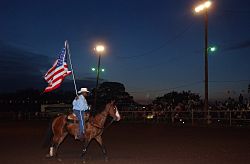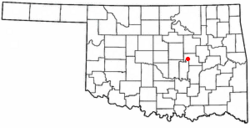Boley, Oklahoma facts for kids
Quick facts for kids
Boley, Oklahoma
|
|
|---|---|

Boley 100th Birthday Rodeo & Bar-B-Q Festival
|
|

Location of Boley, Oklahoma
|
|
| Country | United States |
| State | Oklahoma |
| County | Okfuskee |
| Incorporated | May 10, 1905 |
| Area | |
| • Total | 1.62 sq mi (4.19 km2) |
| • Land | 1.61 sq mi (4.18 km2) |
| • Water | 0.00 sq mi (0.01 km2) |
| Elevation | 860 ft (260 m) |
| Population
(2020)
|
|
| • Total | 1,091 |
| • Density | 675.96/sq mi (261.00/km2) |
| Time zone | UTC-6 (Central (CST)) |
| • Summer (DST) | UTC-5 (CDT) |
| ZIP code |
74829
|
| Area codes | 539/918 |
| FIPS code | 40-07500 |
| GNIS feature ID | 2411705 |
Boley is a town in Okfuskee County, Oklahoma, United States. It was officially made a town in 1905. Boley was special because it was one of the many towns in Oklahoma started by and for African Americans. Many of its first citizens were also part Native American.
Today, Boley is home to Smokaroma, Inc., a company that makes barbeque equipment. It also has the John Lilley Correctional Center. The town is famous for its Annual Boley Rodeo & Bar-B-Que Festival. The Boley Historic District is a very important place and is recognized as a National Historic Landmark.
Contents
History of Boley
Boley was founded by people known as Creek Freedmen. These were African Americans whose ancestors had been enslaved by the Creek Nation. After the American Civil War, the U.S. government made new agreements with tribes like the Creek. These agreements meant that formerly enslaved people became members of the tribes.
These Creek Freedmen then started their own towns, and Boley was one of them. The town was built on land that belonged to Abigail Barnett-McCormick, whose father was a Creek freedman.
How Boley Started
The Fort Smith & Western Railroad helped Boley grow. The Barnett family's land was a perfect spot for a train station. With the railroad's help, Boley officially became a town in 1905. It was named after J. B. Boley, a railroad official.
Because there were no other towns for Black people nearby, Boley quickly became a center for business in the region. In the early 1900s, Boley was one of the richest Black towns in the United States. It had two banks, including the first national bank owned by Black people. It also had three cotton gins and its own electric company.
By 1911, over 4,000 people lived in Boley. It was home to two colleges: Creek-Seminole College and Methodist Episcopal College. The Masonic Lodge, built in 1912, was known as "the tallest building between Okmulgee and Oklahoma City." Booker T. Washington, a famous educator, visited Boley in 1905. He was so impressed that he often talked about Boley in his speeches.
Boley was known as a place where African Americans could live and govern themselves freely. It even had a sign that challenged racial rules of the time, saying, "White man, don't let the sun set on you here." This sign showed Boley's strong spirit of independence. Federal agents removed the sign in 1924.
Boley's Challenges
Boley's success was closely tied to the railroad. After World War I, farming prices dropped, and the railroad went bankrupt. This caused problems for Boley, and it also went bankrupt in 1939 during the Great Depression.
Before World War II, Boley's population had dropped to about 700 people. Many people moved away to bigger cities for work. Even though many people left, Boley is still one of Oklahoma's important historic African-American towns.
Important Dates in Boley's History
- 1903: Boley is founded.
- 1905: The town is officially made a town. Booker T. Washington visits.
- 1907: Oklahoma becomes a state. New laws are passed that make it harder for African Americans.
- 1911: A pamphlet called Facts about Boley, Okla. the largest and wealthiest exclusive Negro city in the world is published.
- 1922: The movie The Crimson Skull, starring rodeo legend Bill Pickett, is filmed in Boley.
- 1925: A training school for Black boys opens in Boley. It later becomes the John Lilley Correctional Center.
- 1932: Citizens of Boley stop a bank robbery attempt by members of Pretty Boy Floyd's gang.
- 1939: The Fort Smith & Western Railroad and Boley go bankrupt.
- 1959: Smokaroma, a barbeque equipment company, is founded.
- 1961: The first Annual Boley Rodeo & Bar-B-Que Festival is held.
- 1970, 1974, 1976: Boley High School wins state basketball championships.
- 1975: The Boley Historic District is recognized as a National Historic Landmark.
- 2007: Boley High School closes.
- 2010: Boley Elementary School closes.
Plaque Honoring Boley
The Oklahoma Historical Society has a plaque honoring Boley. It says: Boley, Oklahoma Established August 1903 - Incorporated May 1905 Boley, Creek Nation, I.T., was started as an all-Black town on the land of Creek Indian Freedwoman Abigail Barnett. T.M. Haynes was the first town manager. It was named for J.B. Boley, a white railroad official, who believed Black people could govern themselves. This idea quickly helped the population grow to 4,200. The town was declared a National Historic Landmark District by Congress on May 15, 1975.
Geography
Boley is located about 13 miles east of Prague and 11 miles west of Okemah. You can find it on US Highway 62.
The town covers an area of about 1.6 square miles (4.1 square kilometers), and it's all land.
Population and People
| Historical population | |||
|---|---|---|---|
| Census | Pop. | %± | |
| 1910 | 1,334 | — | |
| 1920 | 1,154 | −13.5% | |
| 1930 | 874 | −24.3% | |
| 1940 | 942 | 7.8% | |
| 1950 | 646 | −31.4% | |
| 1960 | 573 | −11.3% | |
| 1970 | 514 | −10.3% | |
| 1980 | 423 | −17.7% | |
| 1990 | 908 | 114.7% | |
| 2000 | 1,126 | 24.0% | |
| 2010 | 1,184 | 5.2% | |
| 2020 | 1,091 | −7.9% | |
| U.S. Decennial Census | |||
In 2020, the population of Boley was 1,091 people. The town has seen its population change over the years. In 1910, it had 1,334 residents, and it grew to over 4,000 by 1911. However, the population later decreased before rising again in recent decades.
The people living in Boley come from different backgrounds. According to the 2020 census, the largest groups are White (53.25%) and Black or African American (29.06%). There are also people who identify as Native American, Asian, and those of mixed race. About 5.41% of the population is Hispanic or Latino.
Arts and Culture
Boley Historic District
A special part of Boley is called the Boley Historic District. It was named a National Historic Landmark in 1975. This area includes streets like Seward Avenue, Walnut and Cedar Streets, and the southern city limits. It's important because it preserves the history of this unique town.
Boley in Movies
In 1922, the famous rodeo star Bill Pickett filmed two movies in Boley: The Bull-Dogger and The Crimson Skull. Pickett is known for inventing "bulldogging," which is now called steer wrestling.
Famous People from Boley
- Cardell Camper – a major league baseball player
- Pumpsie Green – a baseball player who was the first African American to play for the Boston Red Sox
- Zenobia Powell Perry – a talented composer
What Booker T. Washington Said About Boley
Booker T. Washington, a very important leader and educator, visited Boley twice. He was incredibly impressed by the town.
Historian Currie Ballard said in 2017 that Washington thought Boley was "the finest black town in the world." He believed Boley was special because of its business and education, standing out from other Black towns in the nation.
Some things Washington was quoted as saying about Boley include:
- "They have recovered something of the knack for trade that their fore-parents in Africa were famous for."
- "Boley, Indian Territory, is the youngest, most enterprising, and in many ways the most interesting of the Negro towns in the US."
See also
 In Spanish: Boley (Oklahoma) para niños
In Spanish: Boley (Oklahoma) para niños
Images for kids




